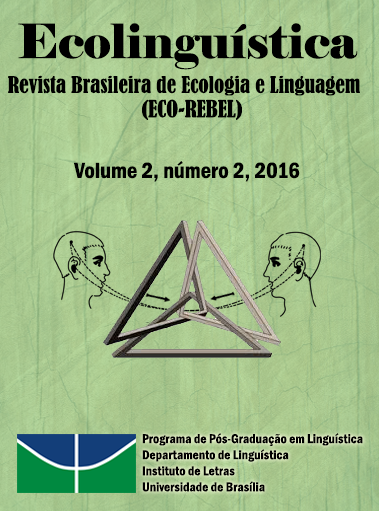Quels fondements pour une écologie des langues?
Keywords:
Ecology of languages; species; evolution; gravitational model.Abstract
he objective of this article is to look for a theoretical foundation for the ecology of languages, utilizing Darwin’s concepts like “origin”, “evolution” and “natural selection”. However, it was chaos theory that inpired me to propose a “gravitational model” to explain the relationships among languages linked by means of bilinguals, as if languages gravitated one around the other. English would a “hiper-central” language, around which some “super-central” languages, like French, Spanish, Arabic and Chinese would revolve. Around these some “central’ languages like Bambara, Breton, and Alsacian would revolve. Around the central language Bambara there are “peripheral” languages like Tamasheq, Peul, Songhay, and Dogon. At each level there are vertical and horizontal bilingualism. Finally, there is an adaptation of transplanted languages to the new ecology, exactly as in the case of transplanted species.
Downloads
References
ABE K.; WATANABE, D. Songbirds possess the spontaneous ability to discriminate syntactic rules. Nature Neuroscience 2011, 14, p. 1067-74.
BASTARDAS I BOADA, Albert. Ecologia de les Llengües. Barcelona: Proa, 1996.
CALVET, Louis-Jean. Pour une écologie des langues du monde. Paris: Plon, 1999.
_______. Essais de linguistique. Paris: Plon, 2004.
_______; CALVET, Alain. http://wikilf.culture.fr/barometre2012/
_______. Les Confettis de Babel. Paris: Ecriture, 2013.
CAVALLI-SFORZA, Luca, Gènes, peuples et langues, Paris, Odile Jacob, 1996.
_______; CAVALLI-SFORZA. F. The Great Human diasporas: The History of Diversity and Evolution. New York: Reading, MA.: Addison-Wesley, 1995.
CRYSTAL, David. Language Death. Cambridge: Cambridge University Press, 2000.
DARWIN, Charles. L’origine des espèces. Paris: Maspéro, 1980.
_______. The Descent of man. Londres: John Murray, 1871,
FILL, Alwin; MÜHLHÄUSLER, Peter. The Ecolinguistics Reader. Londres: Continuum, 2001.
HAUGEN, Einar. The Ecology of language. Stanford: Stanford University Press, 1972.
MUFWENE, Salikoko. The Ecology of Language Evolution. Cambridge: Cambridge University Press, 2001.
MÜHLHÄUSLER, Peter. Linguistic Ecology. Londres: Routledge, 1996.
OUATTARA, K.; LEMASSON, A.; ZUBERBÜHLER, K. Campbell's Monkeys Use Affixation to Alter Call Meaning. PLoS ONE v. 4 n. 11, 2009a.
_______. Campbell’s monkeys concatenate vocalizations into context-specific call sequence », in Proceedings of National Academy of Sciences of the USA. Local: editora,
RUHLEN, Merritt. L’origine des langues. Paris: Belin, 1997.
Downloads
Published
How to Cite
Issue
Section
License
Authors who publish in this journal agree to the following terms:
Authors retain copyright and grant the journal the right of first publication. The work is simultaneously licensed under the Creative Commons Attribution License allowing the sharing of the work with acknowledgment of the authorship of the work and initial publication in this journal.
Authors are authorized to enter into additional contracts separately for non-exclusive distribution of the version of the work published in this journal (e.g., publishing in institutional repositories or as book chapters), with acknowledgment of authorship and initial publication in this journal.
Authors are allowed and encouraged to post and distribute their work online (e.g., in institutional repositories or on their personal page) at any point before or during the editorial process, as this can bring about productive revisions as well as increase impact.
Citation of published works (See The Effect of Free Access).



3.png)



